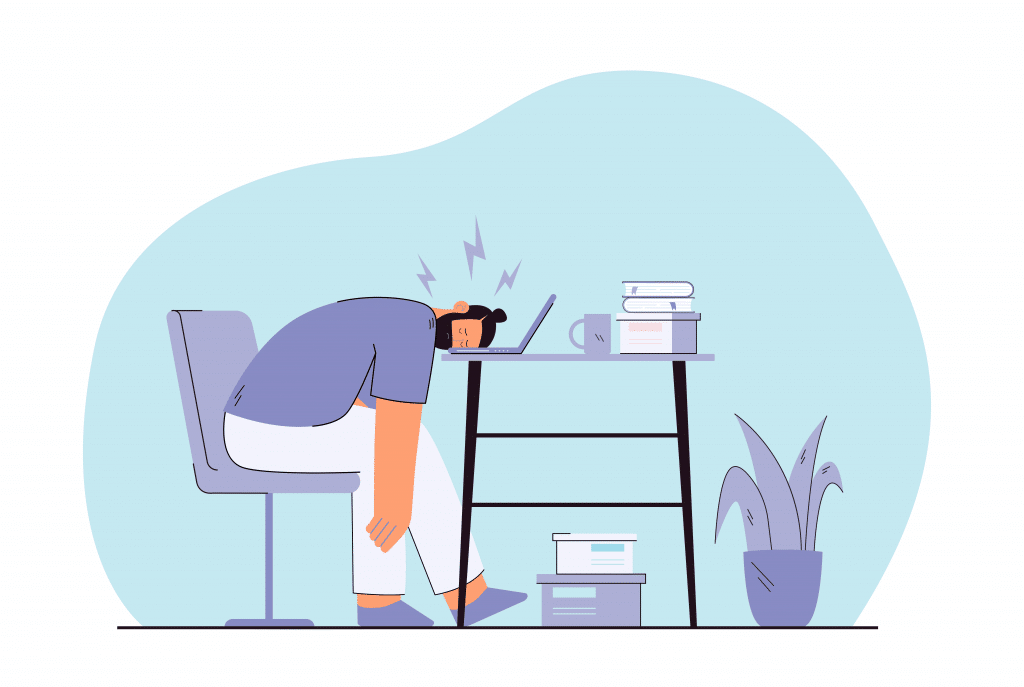Work Related Stress – the Signs, Symptoms, and How to Get Help

We’ve all experienced stress related to work at one point or another in our careers. Work related stress refers to the detrimental emotional and physical effects that occur when an employee’s job requirements exceed that employee’s ability to cope. It is a global phenomenon that has far-reaching implications for both individuals and organisations alike.
While workplaces present multiple challenging situations, what is deemed stressful will differ from individual to individual. Every individual’s experience of, and response to, stress related symptoms at work is also unique. For instance, some individuals may doubt themselves by wondering if they are “too sensitive” or “not capable enough” compared to colleagues.
Conversely, others, having noticed their symptoms of work related stress, might immediately attribute the symptoms to external reasons outside of their own control, such as perceived prejudice from others or others’ undesirable behaviour. Work related stress can have a huge impact on an individual’s physical and mental health, relationships (both at work and in their personal life), motivation, and job performance.
Organisations too, have not been spared the impact of employees’ work related stress. Costs borne by organisations include immense financial costs that are associated with increased healthcare claims from employees, higher turnover rates, poorer job performance, and higher absenteeism rates.
This article therefore covers the possible causes of stress related to work, what individuals can do to recognise and manage their work related stress symptoms better, and how organisations can respond more effectively in relation to stress related work.
Causes of Stress Related Symptoms at Work
There are many possible causes of work related stress symptoms. Some common reasons behind employees’ symptoms of work related stress include, but are not limited to:
- Overtime work and / or work overload
- Interpersonal difficulties and conflicts
- Workplace bullying and harassment
- Constant changes to task requirements
- Organisational changes
- Substandard, unsuitable or unconducive physical work environment
- Poor management style of supervisors
- Lack of clarity about roles and tasks
- Lack of autonomy in deciding what work needs to be done and how work it should be done
- Lack of clarity about or potential for career progression and growth
- Lack of job-related skills training or adequate supervision
- Concerns about lack of job security
These situations can be very frustrating to employees when left unaddressed, and often contribute to employees experiencing various symptoms of work related stress, as discussed in the next section.
Symptoms of Work Related Stress
Is the root of your stress related to work? Although different individuals may experience different stress related symptoms, some of the common symptoms of work-related stress include, but are not limited to:
- Fatigue
- Headaches
- Sleep problems
- Difficulty in concentrating
- Heart palpitations, or a racing heart
- Irritability
- Anger
- Anxiety
- Depression
- Loss or increase in appetite
- Loss of interest or motivation in work
- Poor job performance
Of course, it is possible that many of these symptoms could also occur due to other medical conditions, in which case it might be good to consult a doctor to explore if there might be other causes of your symptoms besides stress related to work.
If you recognise these symptoms in yourself or a loved one, you may be wondering how to deal with work related stress, which we explore in the subsequent section.
Individuals: How to Deal With Work Related Stress
Observe and notice your triggers.
How do you know when you are stressed at work? What do you usually say or do that tells you that you are stressed? Were there times when others asked if you were alright at work or if you were stressed? What was happening then?
Are there specific situations at work that stress you out? Maybe it’s when colleagues based in other countries call you or schedule meetings at unearthly hours, or when colleagues’ slipshod work creates more problems than solutions for you, or when sudden changes occur without prior notice, or when you find out that your colleagues have had a social gathering that excludes you. Or perhaps, instead of being stressed by specific situations, you may find yourself stressed when having to interact with certain people, such as a particular colleague, your boss, or a difficult external client.
What is it about these situations or people that you find most difficult to manage? What is it about these situations or people that you dread the most? Be as specific as you can. Depending on your comfort level, you may also wish to ask family, close friends, or colleagues who work closely with you for feedback. It might also be good to keep in mind that as different people find different things stressful, no trigger is “too insignificant”; what matters is the impact that it has on you. If it is something you are struggling with, it is worth exploring. Being honest with yourself goes a long way in improving your self-awareness.
Experiment with different relaxation strategies to see what works best for you.
Contrary to popular belief or even what the travel industry might try to convince you of, an overseas vacation is not the only way to take a break from work. A break is not only restricted to annual leave, sick leave, or public holidays. A break can be any length of time, like a day, an hour, or even just five minutes. Deep breathing, meditating, talking a walk, being in nature, exercising, listening to a favourite song, spending time with a pet, and taking a short nap are some options. If one relaxation strategy does not work, try another. Be creative with experimenting to find a mix of strategies that work best for you at different times. You can then apply these strategies when faced with your triggers at work. Remember, change does not happen overnight; it will take practice, practice, and more practice, before you begin to reap the benefits of the various relaxation strategies.

Create personal boundaries.
The line between work and personal life is becoming increasingly blurred, particularly with the rise of work from home arrangements. Naturally, what boundaries can be drawn will vary with different work situations. Given your specific work situation, what boundaries are you able to set for yourself? Some examples include setting a time daily after which you do not check your work email, not responding to work calls when in the presence of family or friends, stopping work at a specific time daily (and sticking to it), knowing your limits, saying no when necessary, and taking time off when a break is needed. As they say, when you least have time for a break is when you need one the most. Again, be creative with finding a mix of approaches that are suitable and work best for you.
Improve your communication skills.
Others may not find it easy to know what is on your mind – even if it is obvious to you – until you tell them. A common oversight is to keep things to oneself or attempt to drop hints (which usually don’t work) until one has reached breaking point, before telling others how one feels about a particular issue. The problem with this is that by the time one speaks up about the problem, one is usually very affected by the issue at hand and the message may come across in a less-than-ideal way, potentially leading to conflict. Meanwhile, the receiving party might be taken aback as it might likely be the first time they are hearing about the issue, without any prior knowledge to adjust to or process the message.
Building your communication skills allows you to raise issues early, in a peaceful way that respects the needs of others. You will also likely come across as more composed and professional when communicating your needs. Good communication takes much practice and can include learning assertiveness (as opposed to communicating passively or aggressively), active listening skills, nonverbal communication, using “I statements”, and emotional regulation.
Ask for help.
Oftentimes when we experience stress related to work, it can be hard for us to recognise it ourselves, or to admit the degree to which we are affected. More common, perhaps, is for family and close friends to notice our symptoms of work related stress as they worsen over time, or for colleagues and bosses to notice our stress related symptoms at work. When this occurs, it may be good to give the feedback you have received some thought and consider if there is any weight to it. If so, asking for help might be your first step to managing stress related to work better.
You may wish to bring the matter up with your supervisor to discuss the options provided by your organisation. There is also no shame in asking for help from family, friends, or colleagues you have a close relationship with. After all, if the roles were reversed, would we not do the same for them? However, cultural factors may influence some individuals to feel that sharing their troubles with a loved one may burden them. In such cases, face-to-face therapy or online therapy could provide a safe environment to pour out what’s on your mind. In fact, a therapist could also work with you on the above three points. Having regular sessions with a therapist may also help to increase your commitment to change. You may also wish to check if your company has an existing Employee Assistance Programme which includes one-on-one therapy, work-life balance options, and skills training. Depending on your country and jurisdiction, you may also wish to consider other practical matters, such as seeking legal advice on how to prepare claim for work related stress.
The question of how to deal with work related stress is a common one that is asked globally, so if you are experiencing symptoms of work related stress, know that you are not alone, and that there are solutions for you. Work stress related symptoms can be better managed by identifying your triggers, experimenting with different relaxation strategies to find a mix that works best for you, drawing up personal boundaries to improve work-life balance, improving your communication skills and practising them so that concerns may be raised early, and asking for help from close colleagues, supervisors, friends, and family, as and when it is needed.

Organisations: How to Deal With Work Related Stress Of Employees
Organisations have a duty of care towards their employees, which includes employees’ mental wellbeing at work. It would be wise for organisations to take a proactive approach rather than a reactive one in relation to employees’ stress related to work. Creating a healthy and positive work environment can go a long way in boosting workplace morale, building employee loyalty, and in turn, retaining good employees. Here are some simple ways to do so:
Ensure realistic expectations and reasonable workloads.
This may sound obvious, but it is often the cause of much employee stress. Organisations with higher turnover rates and organisations that are understaffed may be especially prone to this as workloads shift around inevitably. Employees who are required to report to multiple managers may also face additional and conflicting expectations from different departments. Organisations should thus take extra care in ensuring that individual employees are not overloaded with work beyond what they are capable of handling, and that expectations of each employee are clear and manageable.
Have regular check-ins to stay updated on employees’ wellbeing.
Instead of waiting for the periodical appraisal, engage in regular informal conversations or check-ins with employees to ensure that symptoms of work related stress are identified and addressed early. Employees may also be encouraged to check in on fellow employees if they notice any symptoms of work related stress, as colleagues who work closely with each other are sometimes the first to notice such symptoms. An additional benefit of this is that any work-related issues may be highlighted and ironed out more objectively when raised early.
Create a culture where employees may raise concerns safely.
There may be various situations which result in work related stress where employees may not speak up about, out of fear that it may negatively impact their career.Management may still be able to get a sense of the ground sentiment by implementing an organisation-wide suggestion system that would allow employees to raise concerns safely and anonymously. In this way, otherwise-hidden issues that only a certain group of employees might be aware of can be uncovered and addressed as early as possible, thereby preventing further escalation of matters.
Additionally, a safer workplace culture may be cultivated if supervisors remain available, approachable, and open to hearing the concerns of their supervisees without the supervisees having to fear any negative repercussions. Some organisations also adopt an open-door policy to encourage employees to raise issues directly to senior management.
While whistleblowing policies are now commonplace in many organisations worldwide, employees are often unaware that their organisation has such a policy, or how they may go about using the policy when needed. It is thus important to ensure that organisations disseminate information on organisational policies and channels effectively, so employees are well-aware of these and can raise their concerns in a safe manner.
Acknowledge and appreciate employees’ effort and contributions.
Acknowledging employees’ efforts and contributions need not only occur at formal platforms such as an annual company dinner or when employee of the month awards are given out. It is good to acknowledge and appreciate employees’ efforts as and when they occur, such as when they put in an extra hour of work to accommodate a supervisor’s or client’s last minute request, when they have written a report well or conducted a presentation well, when they managed to deescalate a conflict, when they took the initiative to go out of their way to assist a colleague from another department, and so on. It is often the small things that make a big difference.
Explain the rationale for organisational changes.
When organisational changes occur, the decision making process often takes place within top management. By the time the information trickles down to individual employees, employees may only be informed of the changes they need to make to their own individual work, which may include altered or additional tasks. Without full understanding of the rationale for the organisational changes, it is natural for employees to perceive these tasks as unnecessary additions to their often already high workload, resulting in frustration and stress related to work. Clear communication from senior management to ensure that employees fully comprehend the rationale behind organisational changes is often helpful in reducing employee’s stress related to work.
Encourage work-life balance and self-care.
What works for one employee may not necessarily work for another. Organisations may consider offering flexible arrangements that allow employees to manage their stress related to work better. Flexibility can take place in various forms, such as flexible work locations and hours where possible, providing exercise equipment or exercise programmes, and encouraging and perhaps even enforcing breaks when necessary. Of course, these measures are only useful if they are actually practised in reality; managers therefore need to set the example themselves, in order to convey the message to employees that they may engage in such activities as it is in line with the organisational norm or culture. Organisations should refrain from implementing such measures as “band-aid” solutions to improve work culture in lieu of any broader structural changes that may be required.
Provide a formal Employee Assistance Programme.
Employee Assistance Programmes have been increasing in popularity due to the flexibility in tailoring services specifically for an organisation, and the benefits brought about by such services. Services provided in an Employee Assistance Programme include one-on-one counselling sessions, webinars, focused discussions on pre-set topics, workshops and training relating to personal development (such as effective presentation skills and public speaking), professional development (such as assertiveness at work and managing interpersonal conflict at work), and mental wellness (such as mindfulness, dealing with anxiety and stress related to work). Aside from helping employees manage their work stress related symptoms better, Employee Assistance Programmes can also equip supervisors with the right skills to respond more effectively to their supervisees’ work stress related symptoms. Other benefits of an Employee Assistance Programme include increased productivity, increased employee retention and lower turnover costs.
When considering how to deal with work related stress of employees, it would be prudent for organisations to take a preventive approach, rather than a reactive one, in creating a safe work environment for employees. This includes ensuring that workloads are manageable and expectations of employees are realistic, conducting regular informal check-ins with employees to stay updated about their physical and emotional wellbeing, creating channels for employees to raise their concerns safely, acknowledging and appreciating employee’s efforts and contributions in small ways, ensuring that employees fully understand the rationale behind organisational changes, having senior management lead the way by utilising work-life balance policies and demonstrating self-care, and providing a formal Employee Assistance Programme that is tailored for your organisation’s needs. These efforts can go a long way in mitigating and managing employees’ stress related to work.
Stress Related to Work
In summary, stress related to work is a common occurrence that have profound costs for both individuals and organisations globally. While employees have a responsibility to manage their own physical and mental wellbeing and symptoms of work related stress through personal therapy or other self-improvement and self-care methods, organisations should do their part by providing a physically and emotionally safe working environment, and providing employees with informal and formal ways to manage their work stress related symptoms. One way to provide comprehensive support to employees is to offer an Employee Assistance Programme with various options for senior management, supervisors and employees to choose from, depending on each individual’s needs. Aside from taking practical steps to address the causes of stress related to work, senior management should also make the organisational policies clear to employees, and walk the talk by demonstrating that the organisational policies that are in place are meant to be used, without fear of repercussions to one’s career.
Subscribe to Our Newsletter
Interested in joining our newsletter and staying connected?
Drop your email address below to receive mental health news, latest TYHO articles, and tips delivered to your inbox monthly.




